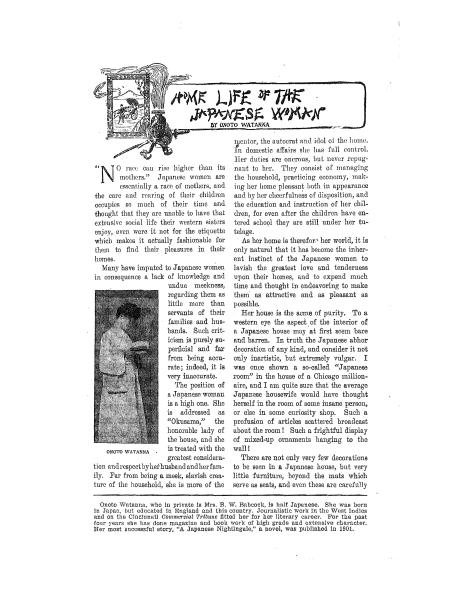“No race can rise higher than its mothers.” Japanese women are essentially a race of mothers, and the care and rearing of their children occupies so much of their time and thought that they are unable to have that extensive social life their western sisters enjoy, even were it not for the etiquette which makes it actually fashionable for them to find their pleasures in their homes.
Many have imputed to Japanese women in consequence a lack of knowledge and undue meekness, regarding them as little more than servants of their families and husbands. Such criticism is purely superficial and far from being accurate; indeed, it is very inaccurate.
The position of a Japanese woman is a high one. She is addressed as “Okusama,” the honorable lady of the house, and she is treated with the greatest consideration and respect by her husband and her family. Far from being a meek, slavish creature of the household, she is more of the mentor, the autocrat and idol of the home, in domestic affairs she has full control. Her duties are onerous, but never repugnant to her. They consist of managing the household, practicing economy, making her home pleasant both in appearance and by her cheerfulness of disposition, and the education and instruction of her children, for even after the children have entered school they are still under her tutelage.
As her home is therefore her world, it is only natural that it has become the inherent instinct of the Japanese women to lavish the greatest love and tenderness upon their homes, and to expend much time and thought in endeavoring to make them as attractive and as pleasant as possible.
Her house is the acme of purity. To a western eye the aspect of the interior of a Japanese house may at first seem bare and barren. In truth the Japanese abhor decoration of any kind, and consider it not only inartistic, but extremely vulgar. I was once shown a so-called “Japanese room” in the house of a Chicago millionaire, and I am quite sure that the average Japanese housewife would have thought herself in the room of some insane person, or else in some curiosity shop. Such a profusion of articles scattered broadcast about the room! Such a frightful display of mixed-up ornaments hanging to the wall!
There are not only very few decorations to be seen in a Japanese house, but very little furniture, beyond the mats which serve as seats, and even these are carefully
Onoto Watanna, who in private is Mrs. B. W. Babcock, is half Japanese. She was born in Japan, but educated in English and this country. Journalistic work in the West Indies and on the Cincinnati Commercial Tribune fitted her for her literary career. For the past four years she has done magazine and book work of high grade and extensive character. Her most successful story, “A Japanese Nightingale,” a novel, was published in 1901.
8put away when the room is vacated. Small tables, andirons, tobacco boxes, writing desks, and all such furniture are laid out of sight except when in use. In fact, a Japanese room is almost entirely empty. Nevertheless, the delicate lattice and paper screens which serve as walls, the beam-work with its paneled spaces, the unbroken floor expanse with the soft, closely fitting mats which serve as the flooring and fill every inch of the floor-—these make up an abode in which there is no necessity for decoration.
In one room, however, the Japanese “Okusama” reserves one place for decoration in her house. This is in thezashiki (parlor or guest room), and it is called the Tokonona or place or honor. This spot is fashioned of the finest and most precious of woods. In this niche is hung the Kakemona or scroll picture selected for the time being from the storehouse of the family and changed from time to time, so that one might never become weary of the spot. Beneath this blooms the flower of the season, and in this land of flowers there is no season that is barren of beautiful flowers.
It is the pride of the Japanese housekeeper to keep this spot always fresh and sweet. Upon the chance call of a visitor it serves as a pleasant topic of conversation, taking the place of the weather so repeatedly discussed by the western hostess and her caller. Often the stone of particular curio in the Tokonona is of priceless value and bears an interesting history. The hostess is always flattered when asked to speak of her Tokonona decoration, and her visitor seldom sees the same one on the occasion of other visits.
Most of the Japanese families arise with the sun, the birds and the flowers. While the servant is preparing the breakfast meal the Japanese mother and father have taken their little brood either for a short brisk walk or have given them the fresh morning air in their little garden at the back of the house. After breakfast there is a short rest and then the family indulges in a general bath. Often the whole family bathe in the pond in the garden. After the bath the father departs for his work, the older children to school, while the younger ones undergo their first schooling at the hands of their mother. Even while
9they are very little children she is anxious to try their baby ability to talk. She teaches them how to sit politely on the floor, how to eat their meals, how to speak correctly. Thus from its earliest years the Japanese child is firmly but gently disciplined. Where there is a very small baby the mother, when she can afford it, sends it out in the morning to a professional nurse, or hires a woman to take entire charge of it in the house while she is about her other duties.
After an hour the little ones are allowed to go out and play in the garden, though they are not permitted to run around too much or play rough games. They must reserve such games necessarily for the fields, and they are always impressed with the importance of in no way spoiling the plants and flowers in their garden. Meanwhile, the mother, either in the garden with the children or in a room from where she can keep an eye on them constantly, spends a couple of hours in sewing. She usually makes not only her own and her husband’s garments, but those of her children, though the latter, as soon as they are old enough to handle a needle, assist her. Very often a grown up daughter takes the entire work from her mother’s hands,
When she has finished her sewing for the day all the litter is carefully cleared away. She goes thoroughly over her house to see that it is in spotless condition. There is no more exacting housekeeper than a Japanese woman,
When the weather permits the Japanese mother spends much of her time with the children in the fields. She will find some pleasant spot under a blossoming tree whence she can, while watching her children and engaging her hands in sewing, at the same time feast her eyes upon the lovely scenery that surrounds her and whose influence she knows must add to her serenity and amiability of mind. No mother of any land is more feared, yet tenderly obeyed and loved. This may be because her authority is ever of that gentle reasoning sort which, while exacting unquestioning obedience, is never explosive. No Japanese woman who desires the respect of her children will permit herself to exhibit before them such emotions as irritation, rage, or ungovernable anger with them for acts of refractoriness, no matter how grave.
The Japanese are essentially out-of-door people, and most of their lives are spent in the sun, The sun has a beneficent influence upon one’s temperament. How much gentler the mother under the blossoming tree and the shining sky than the irritable, worn-out mother with her restless brood of whiners in the shadow of the house. The Japanese believe that by letting their eyes continually behold the beauty of nature their beauty of soul and character must expand and blossom also.
In the afternoon the lady of the house takes her drive in her jinrikisha. Sometimes she drives merely through the woods and pathways, but more often she shops in the city, and sometimes stops at her husband’s place of business and brings him home with her, for while work must commence early, so it ends early for the business man in Japan.
On a certain day in the week the Japanese woman, like the American, is at home to her friends, and on another day she pays a number of calls, sometimes merely sending in her card without even alighting from her jinrikisha. In this way she can make a great many calls during the day.
A Japanese family retires at sundown; at all events the children are never allowed to remain up after dark. Sometimes, however, the parents attend banquets and parties in the evening. The month of August is particularly given up to banqueting. Banquets are held chiefly in the honor of the full moon, as it is to be seen at its best during this month. Some particularly charming spot is chosen, and a gathering of jovial friends meet to drink tea or
saké together and enjoy the serene beauty of the moon rising from behind a mountain
10or reflected on the shining mirror of a lake, a scene which never fails to call forth poetical effusions from the admirers of nature. This constitutes the home life of the average Japanese woman. Quiet, simple, placid, and uneventful it may seem. And yet she is very, very happy, very contented. Deeply rooted in her mind, nurtured and developed in the soil of feudalism, is the Japanese habit of
“taking things easily.” She is not, however, insensible to the hard grind of facts in this earthly life, but her mode of living has been so free from rush and nervous strain that she is prone to go through life seeking the sunshine and shunning the shadows.
Every month in the year has its fete day devoted to some traditional enjoyments, chiefly flower festivals, and the Japanese woman’s life is a-ripple with the gentle excitement of these monthly events. So passionate is her love for nature and the flowers that every month she will make regular visits to different flower resorts of the metropolis, and all the rest of the month the sweet, refining influence of the flower festival is upon her and her household,
Once in a rare while events of national importance mar her life of innocent pleasures; as, for example, when a war cloud hangs over her beloved nation. Then it is seen that she has a spirit less fragile than her body, and deeds of surpassing heroism have been attributed to her in such emergencies. She will give up bravely and with a passionate gladness the ones in whom she has labored so lovingly to instil those instincts that to the Japanese mind are almost a holy passion. Sometimes, too, but rarely, the little woman’s life is marred by a vicious and cruel husband. But divorces are the exception and not the rule. If her life is narrow she is nevertheless happy within its limits. She desires no more strenuous life beyond her own home.

